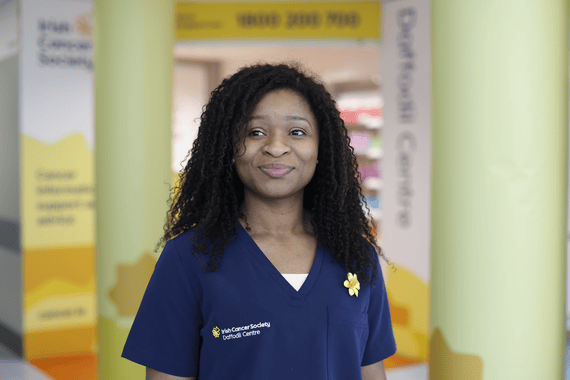Sarcoma
Diagnosis and tests
Diagnosing sarcoma
Your family doctor (GP) will talk to you about your symptoms. Your GP will refer you to hospital if they think you need more tests.
Non-cancerous (benign) lumps are very common but can look similar to a sarcoma. For this reason, you may have to see several doctors and have several tests to get a diagnosis.
Apart from X-rays and blood tests, other tests you might have include:
A scan that uses magnetic energy to build up a picture of the tissues inside your body. During the scan you will lie inside a tunnel-like machine.
Read more about MRI scans.
A type of X-ray that gives a detailed picture of the tissues inside your body.
Read more about CT scans.
A device like a microphone passed over your body to give a picture of the tissues inside. It can show any abnormal changes.
Read more about ultrasound scans.
A radioactive injection that will show up any cancer spread to other parts of your body on a CT scan picture.
Read more about PET scans.
Your doctor will take a sample of the tissues from the lump and have it looked at by an expert (pathologist).
A needle is placed in the lump to take a sample of cells. The needle used in a core biopsy is slightly larger than those used in a fine needle aspiration. You will first be given a local anaesthetic so that you cannot feel any pain. If the lump is deep, your doctor will use an ultrasound scan or CT scan to see where the needle is going and guide it into the right place. Children usually have a general anaesthetic.
A piece of the lump or the whole lump is removed through a cut (incision) in your skin. Removing the whole lump is called excision biopsy. You will have a local anaesthetic or a general anaesthetic, depending on where the lump is and how big it is.

If you are diagnosed with sarcoma, we're here for you.
Our cancer nurses are here if you need information or just want to talk. They can help you to understand your diagnosis and what to expect, send you information and tell you about our services.
Further tests for sarcoma
You may need further tests to give your doctors more information about your general health and about the cancer.
The tests you have can help to:
- Stage your cancer. This means finding out the size and position of the cancer.
- Grade your cancer. Grading describes how quickly the cancer may grow and spread and how it might respond to treatment.
Some tests may be used see how you are responding to treatment.
Waiting for test results
While some results may come back quickly, others may take a few weeks. Waiting for results can be an anxious time. It may help to talk things over with your doctor or nurse or with a relative or close friend. You can also call our Support Line on 1800 200 700 or visit a Daffodil Centre to speak to a cancer nurse.
What are the stages of sarcoma?
Staging means finding out how big the cancer is and if it has spread to other parts of your body. Staging will help your doctor to plan the best treatment for you.
TNM staging system
Sarcomas involving the trunk (chest, tummy (abdomen) and back) and extremities (arms and legs) are staged using the TNM system. This stands for:
- T1 means the tumour is 5cm or less across.
- T2 means it is greater than 5 cm.
- The letter ‘a’ (T1a, T2a) indicates that the tumour is near the surface of the body
- The letter ‘b’ (T1b, T2b) indicates it is deeper in the body.
- N0 indicates that the tumour has not spread to the lymph nodes.
- N1 means that it has spread to the lymph nodes.
- M0 means that the tumour has not spread
- M1 indicates that the tumour has spread to other parts of the body.
Number staging
Your doctor often uses the TNM information to give your cancer a number stage – from 1 to 4. A higher number means a more advanced cancer.
This stage has two subcategories:
- Stage 1A: The tumour is smaller than 5cm across and has not spread to the lymph nodes or to distant sites. At this stage, the cancer is considered grade 1, or it cannot be assessed.
- Stage 1B: The tumour is larger than 5cm across and has not spread to the lymph nodes or distant sites. It is either grade 1 or cannot be assessed.
This stage has two subcategories:
- Stage 2A: The tumour is not larger than 5cm across, and it has not spread to the lymph nodes or distant sites. The cancer is grade 2 or 3.
- Stage 2B: The tumour is larger than 5cm across and has not spread to the lymph nodes or distant sites. The cancer is grade 2.
Can describe as the following:
- The tumour is larger than 5cm across and has not spread to the lymph nodes or distant sites. The cancer is grade 3.
- The tumour can be any size, and it has spread to nearby lymph nodes but not distant sites. The cancer can be any grade.
The tumour can be any size and any grade. It may or may not have spread to the lymph nodes, but it is has spread to distant sites.
Knowing the stage and grade of your cancer helps your team to plan the best treatment for you.
What are the grades of sarcoma?
The grade of a cancer describes how abnormal the cells look under the microscope compared to normal, healthy cells and how the cancer might behave – for example, how quickly it might grow and how it might respond to treatment. The cells are taken during a biopsy.
- Low-grade cancer cells look similar to normal cells and are less likely to spread.
- High-grade cancer cells look very different from normal cells and may grow quickly.
Soft tissue sarcomas are graded from 1 to 3 using a classification system known as the French Federation of Cancer Centers Sarcoma Group (FNCLCC) system.
This system looks at:
This is a score of how many cells are actively dividing within the tumour.
This refers to how many tumour cells are beginning to die off within the tumour.
This is a measure of how closely the tumour resembles normal tissues. For example, a low grade leiomyosarcoma will be made up of cells that look like normal smooth muscle cells.
Each area has a score of 1, 2 or 3. The final grade is calculated by adding up the scores for each area.
Overall score of 2 or 3 (for example, mitotic score 1 + necrosis score 1 = 2)
Overall score of 4 or 5
Overall score of 6 or more.
A lower grade (grade 1) means the cancer is less likely to grow and spread.
Staging and grading can be hard to understand, so ask your doctor and nurse for more information if you need it.
Continue reading about sarcoma




Get help & support

Support Line
Free support pack

